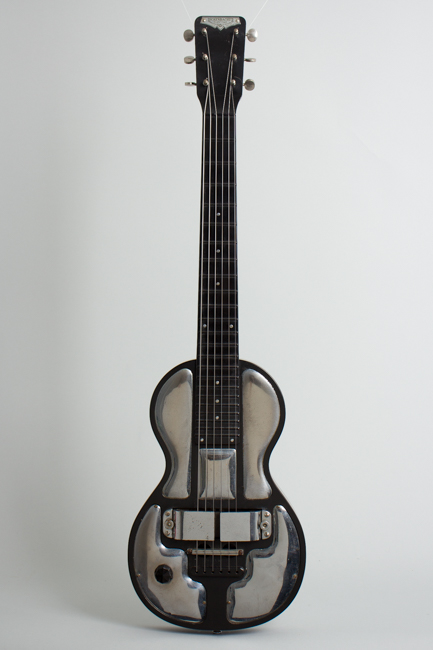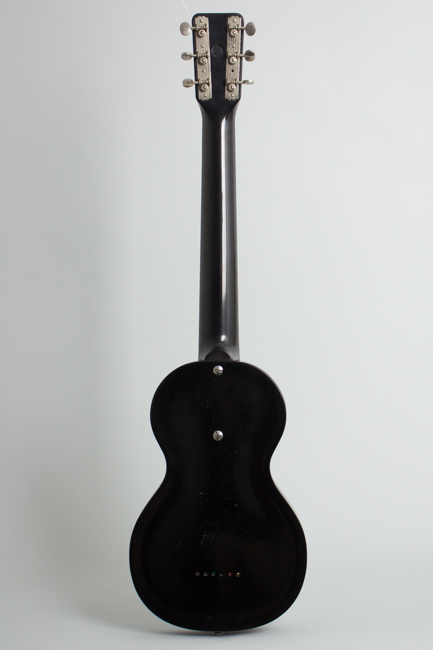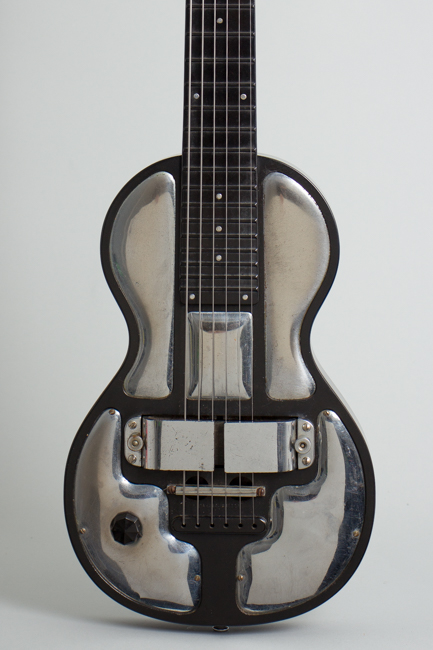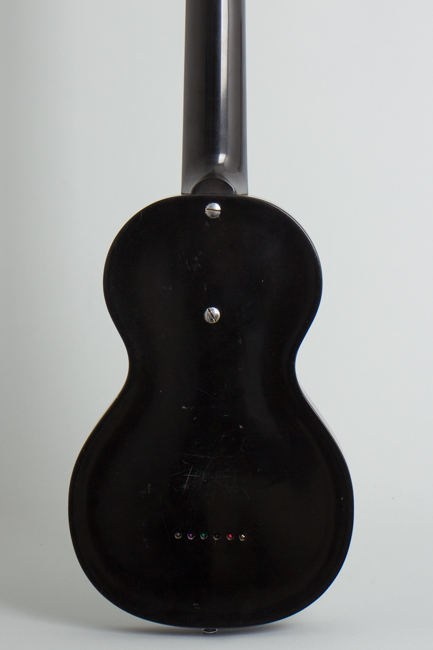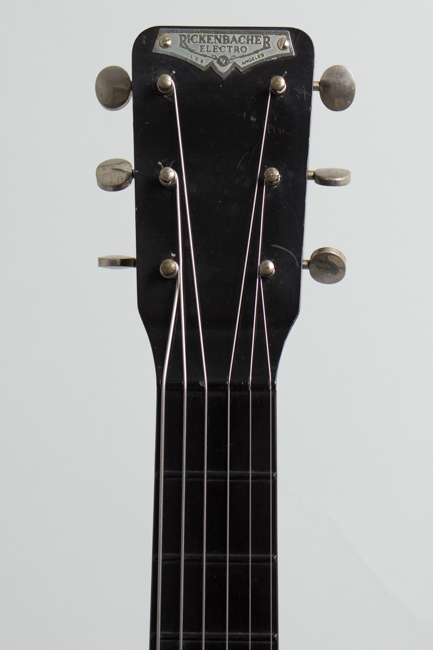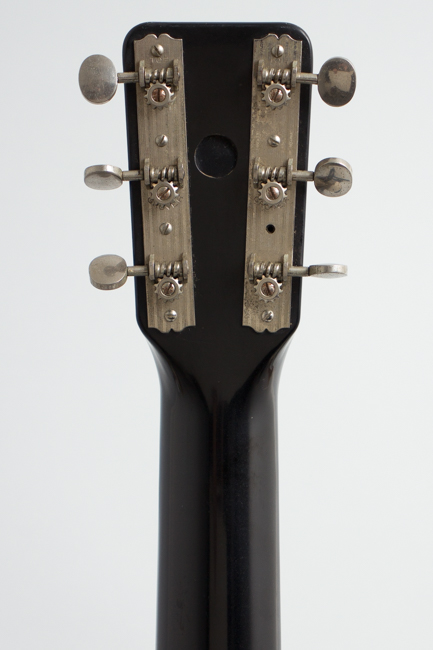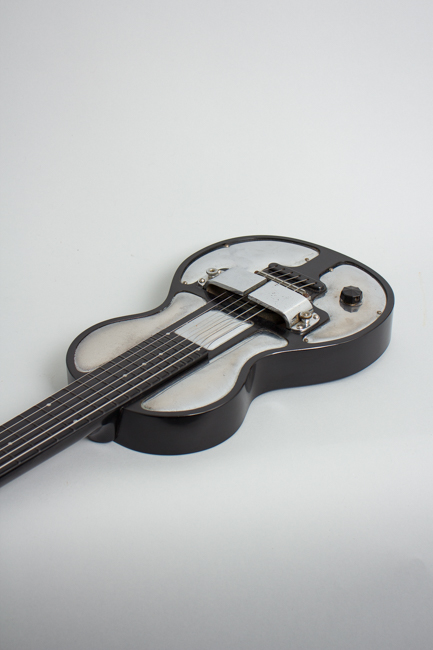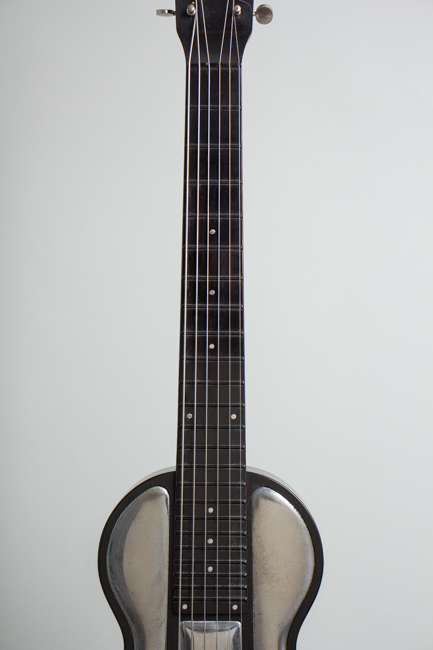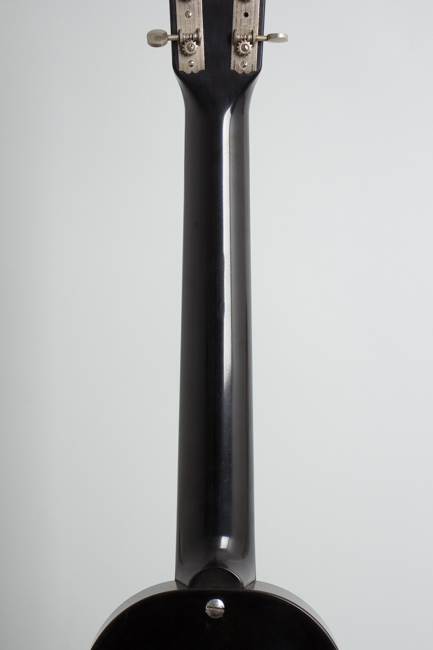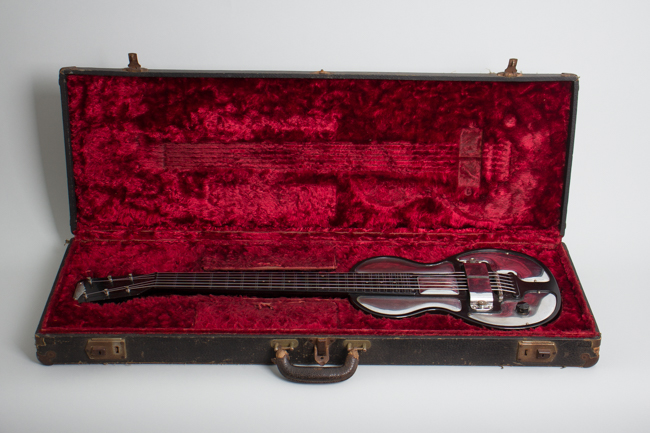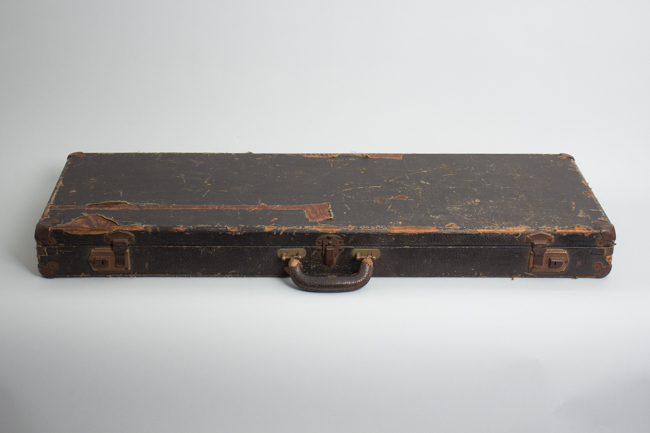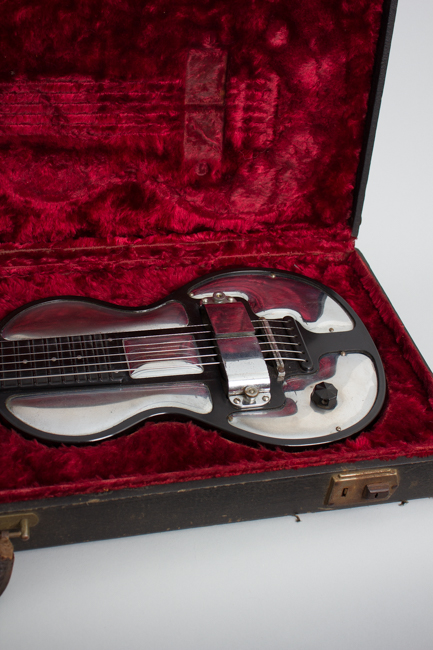Rickenbacker Electro Spanish Solid Body Electric Guitar (1935)
This item has been sold.
Item # 11435
Prices subject to change without notice.
Rickenbacker Electro Spanish Model Solid Body Electric Guitar (1935), made in Los Angeles, serial # B69, polished black finish, molded Bakelite body and neck, original black hard shell case.
This is a VERY early example of one of the most historically interesting American guitars ever built: the Rickenbacker Model B Electro Spanish, the first commercially important electric standard guitar. Introduced in 1935 at the same time as the famed Bakelite Model B Electro Hawaiian Guitar, the Electro Spanish Guitar was not nearly as successful and subsequently only saw limited production for the next few years. Rickenbacker offered several wooden hollow-bodied Spanish electrics during the same era but this is their most radical and purest attempt at a solid-body fully electric Spanish guitar, issued well before there was a market for such an instrument.
The plain Electro Spanish was followed several years later by the even more radical Vibrola Spanish, essentially the same guitar with an internal motorized vibrato device. Clayton Orr "Doc" Kauffman was the inventor of this system, and interestingly the Fender Broadcaster designed a few years after Kauffman's partnership with Fender carries on several features of the Electro-Spanish guitar including the bolt-on neck (considered an easily replaceable part), the through-body stringing, and the bridge-mounted steel-guitar position pickup. The Electro-Spanish can be seen as the progenitor of the entire California family of solid-body guitars to come.
This guitar is an extremely early model dating to the introductory year 1935. The serial number B69 is stamped on the top edge of the headstock which marks it as one of the first 100 or so Bakelite "B" models ever assembled, Spanish OR Hawaiian. Specific features later changed include a single octagonal volume knob and output jack both mounted on the bass side. The molded black Bakelite body has five cavities covered by decorative chrome plates; the top three are not screwed in but held in place with hide glue. The solid aluminum bridge is screwed to the body and has a compensating ridge on the top. The strings run through the body emerging from a molded block just behind the bridge. The horseshoe magnet pickup wraps over the strings and has the famed pre-war 1-1/2" wide magnets; the mounting bracket is the first variation and has no patent markings at all.
The round-profile detachable neck joins the body at the fourteenth fret, has twenty-three integral molded fret ridges and an integral nut and is bolted on by two large screws. The tuners are original chrome-plated strip Grovers with metal buttons. The metal nameplate screwed to the headstock carries the company logo with the old-style spelling "Rickenbacher Electro, Los Angeles" above lightning bolts.
The Electro-Spanish is far rarer than the more familiar Hawaiian variation, which uses some of the same components but a different body and neck. Few players today have ever even handled one. While some of the design features now seem awkward (especially the molded Bakelite frets and the short steel-guitar like scale length), the astounding thing about this little guitar is how good it sounds. The heavy Bakelite body and horseshoe magnet pickup combine to produce an extremely powerful singing tone familiar to steel guitarists who still prize the Bakelite Hawaiian guitar, but virtually unique in a Spanish guitar.
Although today primarily seen as a museum-grade collector's piece, this Electro-Spanish Guitar is also a wonderful musical instrument, albeit an eccentric one. This example was a personal instrument of noted guitar historian/author John Teagle, who passed away last year. John did much original research on early 1930s electric instruments, and this first-issue Model B was one of his prized possessions. It includes the extremely rare original deluxe model rectangular case, with a deep red plush lining and formed inserts surrounding the guitar.
Overall length is 32 7/16 in. (82.4 cm.), 9 1/4 in. (23.5 cm.) wide at lower bout, and 1 3/4 in. (4.4 cm.) in depth, measured at side of rim. Scale length is 22 1/2 in. (572 mm.). Width of nut is 1 3/4 in. (44 mm.).
This is an all original and relatively clean example of this rare and very historic guitar. Apart from some scuffing and light scratching overall and some light corrosion to the chrome there is not a lot of wear. The Bakelite "frets" show some wear, but not enough to seriously affect play. The neck is not totally straight but more so than most; the instrument is playable, if not to a modern standard which none of these Bakelite neck guitars really are. Still structurally and cosmetically this is a lovely early example of a very historic guitar. Our friend John Teagle owned a number of these Spanish B-6 models through the decades, and B69 was his "Keeper", the pick of the litter. The case has quite a bit more external wear than the guitar but is still solid. Excellent - Condition.
This is a VERY early example of one of the most historically interesting American guitars ever built: the Rickenbacker Model B Electro Spanish, the first commercially important electric standard guitar. Introduced in 1935 at the same time as the famed Bakelite Model B Electro Hawaiian Guitar, the Electro Spanish Guitar was not nearly as successful and subsequently only saw limited production for the next few years. Rickenbacker offered several wooden hollow-bodied Spanish electrics during the same era but this is their most radical and purest attempt at a solid-body fully electric Spanish guitar, issued well before there was a market for such an instrument.
The plain Electro Spanish was followed several years later by the even more radical Vibrola Spanish, essentially the same guitar with an internal motorized vibrato device. Clayton Orr "Doc" Kauffman was the inventor of this system, and interestingly the Fender Broadcaster designed a few years after Kauffman's partnership with Fender carries on several features of the Electro-Spanish guitar including the bolt-on neck (considered an easily replaceable part), the through-body stringing, and the bridge-mounted steel-guitar position pickup. The Electro-Spanish can be seen as the progenitor of the entire California family of solid-body guitars to come.
This guitar is an extremely early model dating to the introductory year 1935. The serial number B69 is stamped on the top edge of the headstock which marks it as one of the first 100 or so Bakelite "B" models ever assembled, Spanish OR Hawaiian. Specific features later changed include a single octagonal volume knob and output jack both mounted on the bass side. The molded black Bakelite body has five cavities covered by decorative chrome plates; the top three are not screwed in but held in place with hide glue. The solid aluminum bridge is screwed to the body and has a compensating ridge on the top. The strings run through the body emerging from a molded block just behind the bridge. The horseshoe magnet pickup wraps over the strings and has the famed pre-war 1-1/2" wide magnets; the mounting bracket is the first variation and has no patent markings at all.
The round-profile detachable neck joins the body at the fourteenth fret, has twenty-three integral molded fret ridges and an integral nut and is bolted on by two large screws. The tuners are original chrome-plated strip Grovers with metal buttons. The metal nameplate screwed to the headstock carries the company logo with the old-style spelling "Rickenbacher Electro, Los Angeles" above lightning bolts.
The Electro-Spanish is far rarer than the more familiar Hawaiian variation, which uses some of the same components but a different body and neck. Few players today have ever even handled one. While some of the design features now seem awkward (especially the molded Bakelite frets and the short steel-guitar like scale length), the astounding thing about this little guitar is how good it sounds. The heavy Bakelite body and horseshoe magnet pickup combine to produce an extremely powerful singing tone familiar to steel guitarists who still prize the Bakelite Hawaiian guitar, but virtually unique in a Spanish guitar.
Although today primarily seen as a museum-grade collector's piece, this Electro-Spanish Guitar is also a wonderful musical instrument, albeit an eccentric one. This example was a personal instrument of noted guitar historian/author John Teagle, who passed away last year. John did much original research on early 1930s electric instruments, and this first-issue Model B was one of his prized possessions. It includes the extremely rare original deluxe model rectangular case, with a deep red plush lining and formed inserts surrounding the guitar.
Overall length is 32 7/16 in. (82.4 cm.), 9 1/4 in. (23.5 cm.) wide at lower bout, and 1 3/4 in. (4.4 cm.) in depth, measured at side of rim. Scale length is 22 1/2 in. (572 mm.). Width of nut is 1 3/4 in. (44 mm.).
This is an all original and relatively clean example of this rare and very historic guitar. Apart from some scuffing and light scratching overall and some light corrosion to the chrome there is not a lot of wear. The Bakelite "frets" show some wear, but not enough to seriously affect play. The neck is not totally straight but more so than most; the instrument is playable, if not to a modern standard which none of these Bakelite neck guitars really are. Still structurally and cosmetically this is a lovely early example of a very historic guitar. Our friend John Teagle owned a number of these Spanish B-6 models through the decades, and B69 was his "Keeper", the pick of the litter. The case has quite a bit more external wear than the guitar but is still solid. Excellent - Condition.
